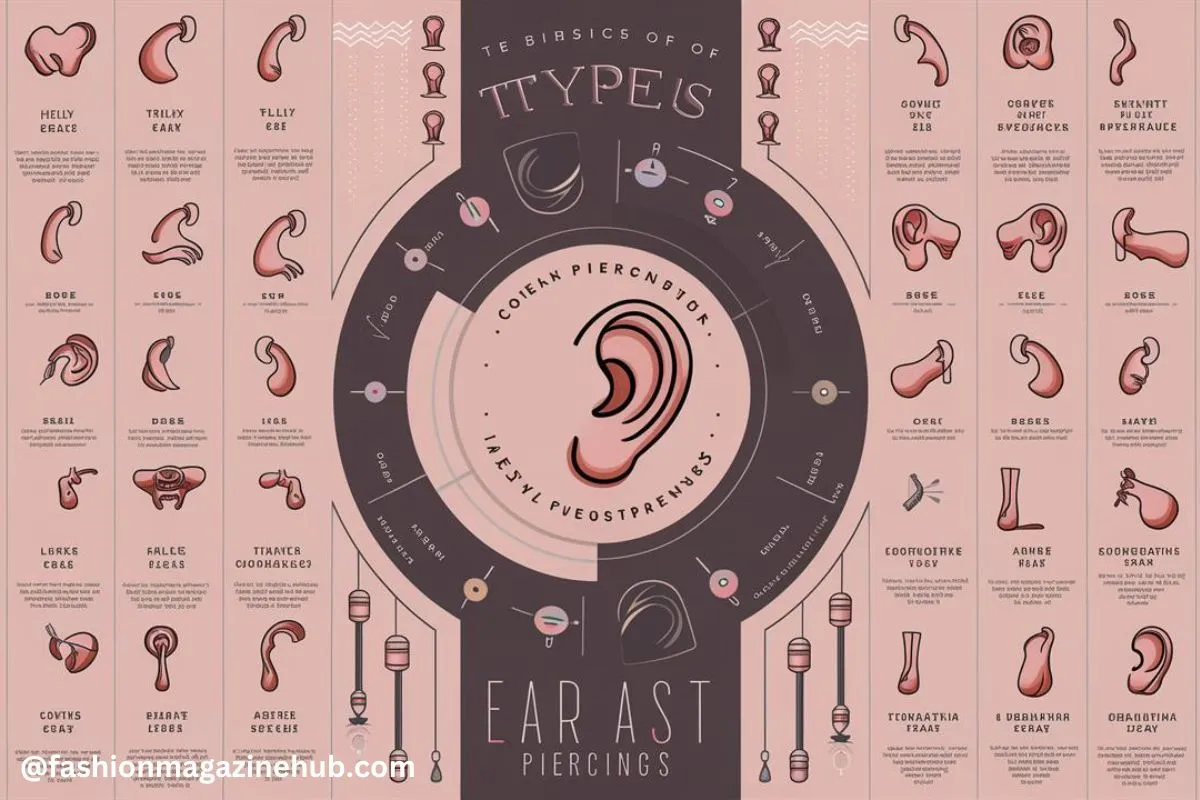The Ultimate Guide To Ear Piercing Chart: Types, Placements, and Aftercare
Ear piercings have been a form of self-expression and cultural significance for centuries. Whether you’re a piercing enthusiast or a newbie considering your first, understanding the different types of ear piercings and their placements is crucial. An ear piercing chart can help you visualize and decide which piercings best suit your style.
The Popularity of Ear Piercings
In recent years, ear piercings have surged in popularity, transcending age and gender barriers. From celebrities to influencers, the trend of sporting multiple ear piercings has made a significant mark. But what exactly makes ear piercings so appealing? It’s their versatility and the ability to customize the look to reflect personal style.
Different Types of Ear Piercings
Here are some Types of Piercings
Lobe Piercings
· Standard Lobe
The most common type of ear piercing, the standard lobe, is typically the first piercing people get. Located at the lowest part of the ear, it’s known for its minimal pain and quick healing time.
· Upper Lobe
The upper lobe piercing is situated above the standard lobe and offers a subtle way to add more earrings without venturing into cartilage territory.
· Helix Piercing
A helix piercing is placed on the upper outer cartilage of the ear. It’s a popular choice for those looking to add a bit of edge to their ear jewelry collection. Healing can take a bit longer than lobe piercings, often ranging from six to twelve months.
· Forward Helix
The forward helix is located on the cartilage just above the tragus, at the front of the ear. It offers a unique placement that stands out, and many people opt for multiple forward helix piercings in a row for a stacked look.
· Industrial Piercing
An industrial piercing consists of two holes connected by a single piece of jewelry, usually a barbell. It typically spans from the helix to the anti-helix, creating a striking and bold appearance. Due
Inner Ear Piercings
· Daith Piercing
The daith piercing is a procedure that involves inserting a needle through the innermost cartilage fold of the ear. Aside from its unique look, some believe it can help alleviate migraines, although there’s no scientific evidence to back this up. It’s a stylish and somewhat mystical addition to any ear piercing collection.
· Rook Piercing
The rook piercing is done on the ridge of cartilage between the outer and inner conch. It’s a subtle yet eye-catching choice, perfect for those wanting to try something different. Healing can be a bit lengthy, taking up to nine months.
· Tragus Piercing
Located on the small, thick piece of cartilage just in front of the ear canal, the tragus piercing is both trendy and bold. It’s often paired with small, delicate jewelry to complement its unique placement. The healing process is typically around six months.
Outer Ear Piercings
· Conch Piercing
The conch piercing is done in the middle part of the ear’s cartilage, which resembles a conch shell. It can be done either as an inner conch (near the ear canal) or an outer conch (closer to the helix). This piercing allows for a variety of jewelry styles, from studs to hoops, making it highly versatile.
· Orbital Piercing
An orbital piercing involves two piercings connected by a single piece of jewelry, typically a hoop. It can be placed in various parts of the ear, but it’s most commonly found in the lobe or the outer ear cartilage. This piercing is great for those wanting a more intricate look.
Ear Piercing Chart Overview
An ear piercing chart is a visual representation of the different types of ear piercings and their placements. It’s an invaluable tool for both piercing professionals and enthusiasts, helping to plan out piercings and understand how they can be combined for a cohesive look. Charts often
Choosing The Right Piercing for You
Selecting the right ear piercing involves several considerations, such as your pain tolerance, lifestyle, and personal style. The text provides several tips to assist in making the best decision:
- Assess Your Pain Tolerance: Some piercings are more painful than others. For instance, lobe piercings are usually less painful compared to cartilage piercings. If you have a low pain threshold, you might want to start with a lobe piercing.
- Consider Your Lifestyle: Think about your daily activities and how a new piercing might affect them. If you play sports or wear headphones frequently, certain piercings might be more prone to irritation or displacement.
- Personal Style: Your piercings should reflect your personal style. Whether you prefer minimalist studs or bold barbells, choose piercings that you’ll enjoy showing off.
- Healing Time: Different piercings have varying healing times. If you’re looking for something that heals quickly, a lobe piercing might be ideal. Cartilage piercings, on the other hand, require more patience and care during the healing process.
The Piercing Process: What to Expect
Getting a piercing can be an exciting experience, but it’s important to know what to expect. Here’s a step-by-step guide to the piercing process:
- Consultation: Your piercer will discuss your desired piercing and assess your ear to determine the best placement. They’ll also explain the procedure, aftercare, and any potential risks.
- Preparation: The piercer will clean the area thoroughly to prevent infection. They’ll also mark the spot where the piercing will be done to ensure precise placement.
- Piercing: Using a sterilized needle, the piercer will make the hole and insert the jewelry
- Aftercare Instructions: After the piercing, your piercer will provide you with detailed aftercare instructions to ensure proper healing.
Pain and Healing Times
The pain and healing time of an ear piercing can vary depending on the type of piercing and individual factors. Here’s a general overview:
- Lobe Piercing: Typically has minimal pain and heals within 6-8 weeks.
- Helix Piercing: Mild to moderate pain with a healing time of 6-12 months.
- Forward Helix Piercing: Moderate pain and takes about 6-9 months to heal.
- Industrial Piercing: Higher pain level and can take 9-12 months to heal.
- Daith Piercing: Moderate pain with a healing time of 6-9 months.
- Rook Piercing: Moderate pain and heals in 6-9 months.
- Tragus Piercing: Mild to moderate pain with a healing period of 6-9 months.
- Conch Piercing: Moderate pain and can take 9-12 months to heal.
- Orbital Piercing: Varies in pain level depending on placement, healing time ranges from 6-12 months.
Aftercare Tips For Ear Piercings
Proper aftercare is crucial for preventing infections and ensuring that your piercing heals correctly. Here are some essential tips:
- Keep It Clean: Clean your piercing twice a day with a saline solution or the aftercare solution provided by your piercer.
- Avoid Touching: Refrain from touching or twisting your piercing unnecessarily.
- Be Gentle: When cleaning or changing jewelry, be gentle to avoid damaging the tissue around the piercing.
- Avoid Submersion: Stay away from pools, hot tubs, and natural bodies of water during the healing process to prevent infection.
- Watch for Signs of Infection: If you notice excessive redness, swelling, pain, or discharge, contact your piercer or a healthcare professional immediately.
Common Issues and How To Handle Them
Even with proper care, issues can arise during the healing process. Common problems and their solutions are listed below:
- Infection: If you suspect an infection, clean the area with saline solution and avoid removing the jewelry.
- Keloids: These are raised scars that can form around the piercing. They’re more common in certain individuals and can be treated with silicone sheets or corticosteroid injections.
- Jewelry Rejection: Sometimes, the body can reject the jewelry, causing it to move or come out completely. If this happens, consult your piercer for alternative jewelry options.
- Irritation Bumps: Small bumps around the piercing site can occur due to irritation. Clean the area gently and avoid any pressure on the piercing.
Ear Piercing Jewelry: Types and Styles
Choosing the right jewelry is essential for both the healing process and your overall look. Here are some popular types and styles:
- Studs: Ideal for new piercings, studs are simple and comfortable. They come in various designs, from classic diamonds to unique shapes.
- Hoops: Hoops are versatile and can be worn in many different piercings.
- Barbells: Commonly used in industrial piercings, barbells are straight pieces of jewelry with balls on both ends.
- Captive Bead Rings: These rings have a bead that’s held in place by the tension of the ring. They’re popular for many types of ear piercings.
- Huggies: Small, close-fitting hoops that “hug” the earlobe or cartilage. They’re great for a minimalist look.
- Clickers: Easy to use and secure, clickers are hoops that click into place. They’re often decorated with intricate designs.
Combining Piercings: Creating Your Unique Look
Combining different ear piercings can create a unique and personalized look. Here are some tips for creating your perfect ear constellation:
- Balance: Ensure your piercings are balanced on both ears. If you have multiple piercings on one ear, consider adding a few to the other ear for symmetry.
- Layering: Mix and match different types of jewelry to create layers. For example, pair studs with hoops or barbells for a dynamic look.
- Themes: Create a theme with your jewelry, such as all gold pieces or a boho vibe with natural stones.
- Spacing: Pay attention to the spacing between piercings. Too close can cause irritation, while too far can look sparse.
Professional vs. DIY Piercing: Pros and Cons
Deciding whether to get your piercing professionally done or to do it yourself is an important choice. Here are the pros and cons of each:
Professional Piercing
Pros:
- Safety: Professional piercers use sterilized equipment and follow strict hygiene protocols.
- Experience: They have the expertise to ensure proper placement and minimize pain.
- Aftercare: Professionals provide aftercare instructions and support if issues arise.
- Variety: Access to a wide range of jewelry and piercing options.
Cons:
- Cost: Professional piercings can be more expensive.
- Scheduling: You might need to book an appointment and wait for availability.
DIY Piercing
Pros:
- Cost-Effective: Doing it yourself can save money.
- Convenience: You can do it on your own schedule.
Cons:
- Risk of Infection: Higher risk due to potentially unsanitary conditions.
- Lack of Expertise: Improper placement and technique can lead to complications.
- Limited Aftercare: Without professional guidance, aftercare can be more challenging.
Conclusion
Ear piercings are a fantastic way to express your individuality and style. Whether you’re considering your first piercing or looking to add to your collection, understanding the different types and proper aftercare is essential. By using an ear piercing chart, you can plan your piercings effectively and create a look that’s uniquely yours. Remember, the key to a successful piercing experience is choosing the right piercing for you, following aftercare instructions, and being patient during the healing process.
FAQs
Do ear piercings hurt?
Yes, there is some pain involved, but it varies depending on the type of piercing and your pain tolerance. Lobe piercings are generally less painful compared to cartilage piercings.
Duration of healing for an ear piercing varies depending on the specific injury?
Healing times vary by piercing type. Lobe piercings typically heal in 6-8 weeks, while cartilage piercings can take 6-12 months.
Can I change my jewelry immediately after getting pierced?
No, it’s crucial to wait until your piercing is fully healed before changing jewelry to avoid infection and irritation.
How do I clean my new ear piercing?
Clean your piercing twice a day with a saline solution or an aftercare solution recommended by your piercer. Avoid using alcohol or hydrogen peroxide.
Piercing gets infected, it is crucial to seek medical attention immediately?
If you suspect an infection, clean the area with saline solution and contact your piercer or a healthcare professional for advice. Avoid removing the jewelry unless instructed by a professional.
Thank you for exploring our Blog! For additional captivating content, feel free to explore the website.


















Post Comment